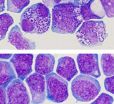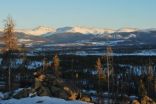(Press-News.org) This news release is available in French.
The Institute for Research in Immunology and Cancer (IRIC) at the Université de Montréal (UdeM), in collaboration with the Maisonneuve-Rosemont Hospital's Quebec Leukemia Cell Bank, recently achieved a significant breakthrough thanks to the laboratory growth of leukemic stem cells, which will speed up the development of new cancer drugs.
In a recent study published in Nature Methods, the scientists involved describe how they succeeded in identifying two new chemical compounds that allow to maintain leukemic stem cells in culture when these are grown outside the body.
This important advance opens the way to the identification of new cancer drugs to fight acute myeloid leukemia, one of the most aggressive forms of blood cancer.
The ability to grow leukemic stem cells in culture is a major breakthrough. The next step is to study the molecular mechanisms that regulate the survival and proliferation of leukemic cells as well as the resistance to cancer drugs.
This study is the work of the "Leucégène" research group. This group is co-directed by Dr. Guy Sauvageau, chief executive officer and principal investigator at IRIC as well as professor in the Department of Medicine at the UdeM; by Dr. Josée Hébert, director of the Quebec Leukemia Cell Bank, hematologist at Maisonneuve-Rosemont Hospital and professor in the Department of Medicine at the UdeM; and by Sébastien Lemieux, principal investigator at IRIC. The first author of the study is Caroline Pabst, a postdoctoral fellow at IRIC and associate of the "Leucégène" research group.
"This research breakthrough demonstrates the advantage of working in a multidisciplinary team like the 'Leucégène' research group," stated Drs. Sauvageau and Hébert. "Access to cells of leukemia patients and to IRIC's state-of-the-art facilities are also key factors in pursuing ground-breaking research."
Background to the study
Stem cells located in the bone marrow are responsible for the production of blood cells. Unfortunately, deregulation of those cells often produces disastrous consequences when one of them develops mutations that transform it into a malignant cell called "leukemic". The result is an abnormal proliferation of blood cells and the development of leukemia. Leukemic stem cells are also one of the likely causes of patient relapse because they are especially resistant to cancer treatments.
The major obstacle before this discovery was growing stem cells and keeping them intact in vitro, because they quickly lost their cancer stem cell character. As a result, it was very difficult to effectively study the multiplication of cells that cause leukemia.
To get around that difficulty, the team of researchers studied leukemic stem cells from patients with acute myeloid leukemia, obtained from the Quebec Leukemia Cell Bank. After thousands of tests using various chemicals, they identified two new chemical compounds that, when added to the culture medium, can keep functional human leukemic stem cells alive for at least seven days in vitro.
"Leucégène" research group
Made up of researchers from the Université de Montréal, the Université Laval and McGill University, the "Leucégène" research group is concerned with the identification of the genes and the factors that determine the chances of recovery from acute myeloid leukemia, and with the discovery of new therapies for this cancer.
INFORMATION:
Funding for this research project
This research project was financed by grants from Genome Quebec and Genome Canada, the Cancer Research Network of the Fonds de recherche du Québec – Santé, Canada Research Chair in Molecular Genetics of Stem Cells, Research Chair in Leukemia, supported by Industrielle-Alliance (Université de Montréal), the German Cancer Aid (Deutsche Krebshilfe) as well as the Cole Foundation.
Major breakthrough in developing new cancer drugs: Capturing leukemic stem cells
2014-03-18
ELSE PRESS RELEASES FROM THIS DATE:
Getting rid of bad vibrations
2014-03-18
Whether you're looking at hairy spider legs, the alien-like faces of ants, or the spiky-looking surfaces of pollen – a scanning electron microscope delivers high-resolution images that are rich in detail. But you can't get perfect images unless you protect the microscope from vibration. If someone walking across the room or an elevator going up and down between nearby floors makes the table shake, you're unlikely to get good results. The simplest way to quell vibrations is to put the microscope on a granite base – a stone so heavy that it dampens vibrations occurring at ...
Who's afraid of math? Study finds some genetic factors
2014-03-18
COLUMBUS, Ohio – A new study of math anxiety shows how some people may be at greater risk to fear math not only because of negative experiences, but also because of genetic risks related to both general anxiety and math skills.
The study, which examined how fraternal and identical twins differ on measures of math anxiety, provides a revised view on why some children – and adults – may develop a fear of math that makes it more difficult for them to solve math problems and succeed in school.
"We found that math anxiety taps into genetic predispositions in two ways: people's ...
Suppressing unwanted memories reduces their unconscious influence on behavior
2014-03-18
Researchers part-funded by the Medical Research Council (MRC) have shown that, contrary to what was previously assumed, suppressing unwanted memories reduces their unconscious influences on subsequent behaviour, and have shed light on how this process happens in the brain.
The study, published online in PNAS, challenges the idea that suppressed memories remain fully preserved in the brain's unconscious, allowing them to be inadvertently expressed in someone's behaviour. The results of the study suggest instead that the act of suppressing intrusive memories helps to disrupt ...
Lessons from a meadow
2014-03-18
For almost 40 years, field scientists strapped on cross-country skis, shouldered backpacks with supplies and set out over three miles of snow and rocks to a field station by a meadow high in the Rocky Mountains as soon as the snow began melting. Every other day, they counted each flower they found, identified the plant it belonged to and kept meticulous records of their observations.
Their observations provide the longest-running scientific study of its kind and tell a story of biological change that teaches scientists new lessons about phenology – the timing of biological ...
Supplements not associated with reduced risk of cardiovascular disease in elderly
2014-03-18
Bottom Line: Daily dietary supplements of omega-3 polyunsaturated fatty acids (also found in fish) or lutein and zeaxanthin (nutrients found in green leafy vegetables) were not associated with reduced risk for cardiovascular disease (CVD) in elderly patients with the eye disease age-related macular degeneration.
Author: The writing group for the Age-Related Eye Disease Study 2 (AREDS2) clinical trial.
Background: Diet studies have suggested that increased intake of fish, a source of omega (ω)-3 fatty acids, can reduce rates of cardiac death, death from all other ...
Study finds high utilization of neuroimaging for headaches despite guidelines
2014-03-18
Bottom Line: Neuroimaging for headaches is frequently ordered by physicians during outpatient visits, despite guidelines that recommend against such routine procedures.
Author: Brian C. Callaghan, M.D., M.S., of the University of Michigan Health System, Ann Arbor, and colleagues.
Background: Most headaches are due to benign causes, and multiple guidelines have recommended against routine neuroimaging for headaches.
How the Study Was Conducted: The authors analyzed National Ambulatory Medical Care Survey data for all headache visits for patients 18 years or older ...
The frozen truth about glaciers, climate change and our future
2014-03-18
Lewis Owen has been scraping out icy fragments of history's truth from one of the most glaciated regions on Earth for the past 25 years.
His frequent excursions to Tibet and the Himalayas have led the University of Cincinnati professor of geology to some cold, hard facts.
Owen knows climate change is immortal – fluctuating across millennia, patiently building toward moments when circumstances are ripe for apocalypse. It was true thousands of years ago, when rapid climate change had profound effects on landscapes and the creatures that lived on them. That scenario could ...
Rice study: Simple changes to homework improved student learning
2014-03-18
A new study offers evidence that simple and inexpensive changes to existing courses can help students learn more effectively.
The study from Rice University and Duke University found that making a few changes to homework assignments in an upper-level undergraduate engineering course at Rice led to improved scores on exams. The study appears this week in the journal Educational Psychology Review.
The findings by a team from Rice's Center for Digital Learning and Scholarship and Duke's Department of Psychology and Neuroscience demonstrate how technology and cognitive ...
Researchers devise new, stretchable antenna for wearable health monitoring
2014-03-18
Researchers from North Carolina State University have developed a new, stretchable antenna that can be incorporated into wearable technologies, such as health monitoring devices.
"Many researchers – including our lab – have developed prototype sensors for wearable health systems, but there was a clear need to develop antennas that can be easily incorporated into those systems to transmit data from the sensors, so that patients can be monitored or diagnosed," says Dr. Yong Zhu, an associate professor of mechanical and aerospace engineering at NC State and senior author ...
A 'back to the future' approach to taking action on climate change
2014-03-18
How can communities dodge future disasters from Mother Nature before she has dealt the blow? Researchers are taking a unique approach to the issue and gaining input and support from community stakeholders. Daniel Murphy, a University of Cincinnati assistant professor of anthropology, will present findings on March 20, at the 74th annual meeting of the Society for Applied Anthropology (SFAA) in Albuquerque, N.M.
The presentation reveals an innovative, interdisciplinary research technique for approaching climate change vulnerability that's called Multi-scale, Interactive ...





